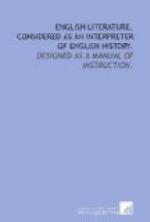“Chivalry was dying; the abbey and the castle were soon together to crumble into ruins; and all the forms, desires, beliefs, convictions of the old world were passing away, never to return;"[27] but this virgin queen was the founder of a new chivalry, whose deeds were not less valiant, and far more useful to civilization.
It is not our purpose, for it would be impossible, to interpret all the history contained in this wonderful poem: a few of the more striking presentations will be indicated, and thus suggest to the student how he may continue the investigation for himself.
THE KNIGHT AND THE LADY.—In the First Book we are at once struck with the fine portraiture of the Red Crosse Knight, the Patron of Holinesse, which we find in the opening lines:
A gentle knight was pricking
on the plain,
Ycladd in mighty arms and
silver shield.
As we read we discover, without effort, that he is the St. George of England, or the impersonation of England herself, whose red-cross banner distinguishes her among the nations of the earth. It is a description of Christian England with which the poet thus opens his work:
And on his brest a bloodie
cross he bore,
The dear remembrance
of his dying Lord,
For whose sweet sake that
glorious badge he wore,
And dead, as living
ever, Him adored.
Upon his shield the like was
also scored,
For sovereign hope which in
his help he had.
Then follows his adventure—that of St. George and the Dragon. By slaying this monster, he will give comfort and aid to a peerless lady, the daughter of a glorious king; this fair lady, Una, who has come a long distance, and to whom, as a champion, the Faery Queene has presented the red-cross knight. Thus is presented the historic truth that the reformed and suffering Church looked to Queen Elizabeth for succor and support, for the Lady Una is one of several portraitures of the Church in this poem.
As we proceed in the poem, the history becomes more apparent. The Lady Una, riding upon a lowly ass, shrouded by a veil, covered with a black stole, “as one that inly mourned,” and leading “a milk-white lamb,” is the Church. The ass is the symbol of her Master’s lowliness, who made even his triumphant entry into Jerusalem upon “a colt the foal of an ass;” the lamb, the emblem of the innocence and of the helplessness of the “little flock;” the black stole is meant to represent the Church’s trials and sorrows in her former history as well as in that naughty age. The dragon is the old serpent, her constant and bitter foe, who, often discomfited, returns again and again to the attack in hope of her overthrow.
THE WOOD OF ERROR.—The adventures of the knight and the lady take them first into the Wood of Error, a noble and alluring grove, within which, however, lurks a loathsome serpent. The knight rushes upon this female monster with great boldness, but




